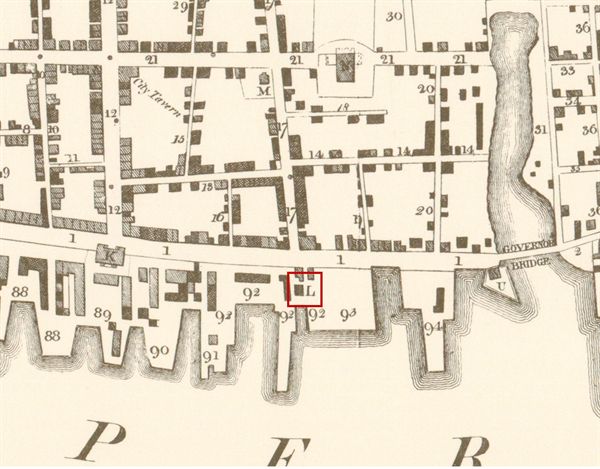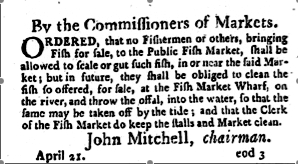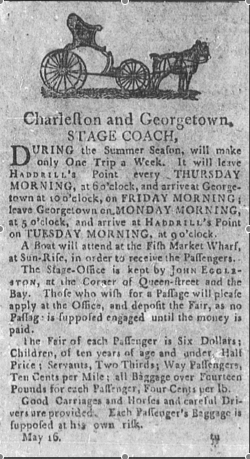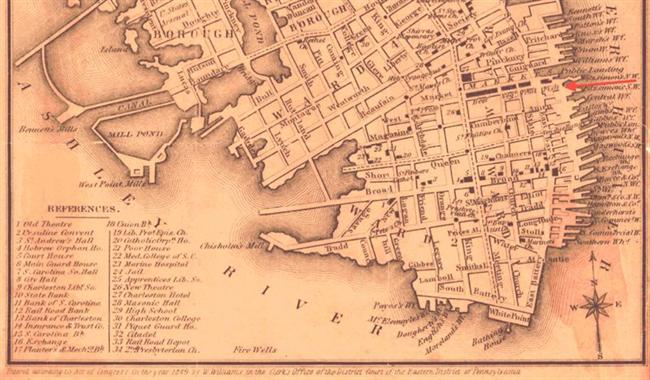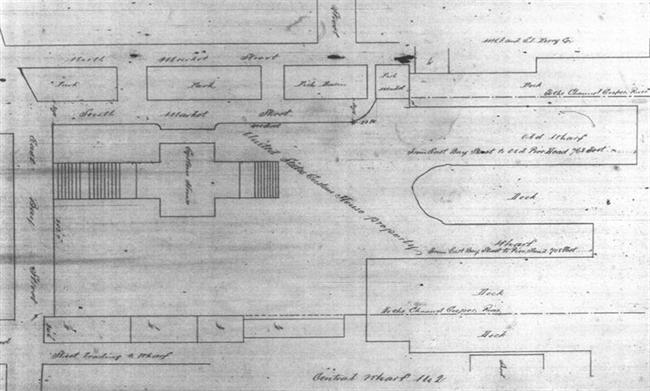31. Fish Market 1770-1807
Charleston's streets and squares were laid out in 1680 according to a plan known as the Grand Modell of Charles Town. The northeast corner of Broad and Meeting streets was designated as a public market place. Over time, other markets were established, most of them near the waterfront, but venders sold fish from temporary stands or benches along the streets near the Cooper River. A public market for fish was established by an Act passed on April 7, 1770, which directed the construction of a suitable building on the water lot below the foot of Queen Street [Queen Street below East Bay Street is now named Vendue Range]. In 1786, City Council ratified an "Ordinance for the regulating and governing of the public markets." Three market places were stipulated: the market established "in the original plan of the city and commonly known by the name of the Beef Market; the market established on the low water lot fronting Tradd Street, at which two markets all kinds of butchers meat, poultry, fruit, vegetables, and all other articles of provision, shall be sold. And the market on the low water lot fronting on Queen Street, for all kinds of fish." From this location extended a wharf which James Denton leased from the city the next year as "…the fish market wharf in Charleston on East Bay Street, adjacent lands of Samuel Prioleau, Esquire, on the channel of the river." Markets were held six days a week, governed by regulations concerning inspections of weights and scales, fines for selling goods outside the markets, and special terms for slaves engaging in commerce. "If any slave shall sell or offer for sale, any kind of provisions or fruit in any of the markets, or any other place in the city (fresh fish excepted) without a ticket from his or her master, mistress, overseer, or employer, particularly enumerating the articles so exposed to sale, it shall be lawful for any white person to seize on all such articles as are not enumerated in their tickets, and to apprehend the said slave, and carry him before any one of the [market] commissioners, who is hereby authorized to examine into the case, and to condemn all such articles not specified in the ticket, for the use of the informer. New regulations were promulgated in August, 1790, requiring "all fishermen who use undecked [small] boats" to sell fish only from the Fish Market, and to pay stall fees according to the weight of fish sold. In 1797, the Commissioners of the Markets advertised for proposals to erect a new Fish Market to be placed east of the existing market buildings on Queen Street Continued. The specifications were for a building 150' long by 20' wide, the "foundation to be sufficiently thick and compact to admit a cistern under the whole, and to be raised 16" above the level of the street. The roof to be supported by Arched Pillars, ten feet high, to be covered with glazed pan tiles, and the eves to project seven feet over the pillars on every side. A cupola sufficient to hang a good bell to be erected on the center of the roof. The inside to be finished with a coved ceiling, lathed and plastered, and the floor made sufficient for the purpose intended." The new building was badly damaged a few years later when a hurricane struck Charleston in September, 1804. Its raised foundation broke, and the east end of the building washed away. A few years later, the Fish Market at the foot of Queen Street was discontinued. The Commissioners of the Centre Market notified the public that the "Fish Market, in Market Street to the eastward of the Governor's Bridge, is now finished, and ready for the use of fishermen." The new Fish Market was on land donated in 1788 to the City of Charleston by Charles Cotesworth Pinckney and others for use as a "public market or markets for the purpose of vending all sorts of butcher meats, poultry, game, fish, vegetables and provisions." Market Hall and the sheds extending from Meeting to East Bay streets are still prominent features in the urban landscape. No trace remains of the Fish Market sheds. Charleston Morning Post, May 12, 1787.
|

